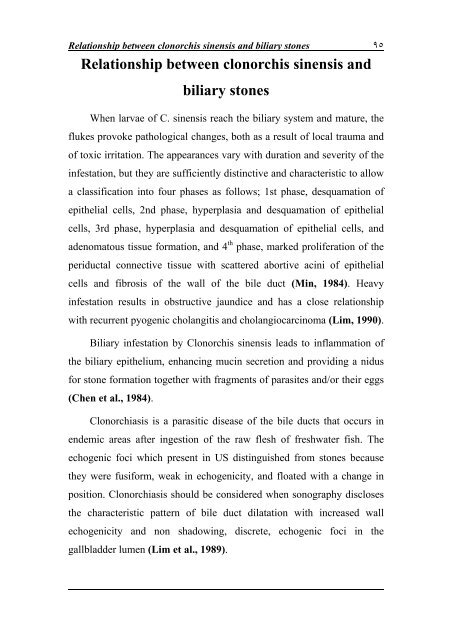Parasites and Biliary stones
Parasites and Biliary stones
Parasites and Biliary stones
Create successful ePaper yourself
Turn your PDF publications into a flip-book with our unique Google optimized e-Paper software.
Relationship between clonorchis sinensis <strong>and</strong> biliary <strong>stones</strong> ٩٥<br />
Relationship between clonorchis sinensis <strong>and</strong><br />
biliary <strong>stones</strong><br />
When larvae of C. sinensis reach the biliary system <strong>and</strong> mature, the<br />
flukes provoke pathological changes, both as a result of local trauma <strong>and</strong><br />
of toxic irritation. The appearances vary with duration <strong>and</strong> severity of the<br />
infestation, but they are sufficiently distinctive <strong>and</strong> characteristic to allow<br />
a classification into four phases as follows; 1st phase, desquamation of<br />
epithelial cells, 2nd phase, hyperplasia <strong>and</strong> desquamation of epithelial<br />
cells, 3rd phase, hyperplasia <strong>and</strong> desquamation of epithelial cells, <strong>and</strong><br />
adenomatous tissue formation, <strong>and</strong> 4 th phase, marked proliferation of the<br />
periductal connective tissue with scattered abortive acini of epithelial<br />
cells <strong>and</strong> fibrosis of the wall of the bile duct (Min, 1984). Heavy<br />
infestation results in obstructive jaundice <strong>and</strong> has a close relationship<br />
with recurrent pyogenic cholangitis <strong>and</strong> cholangiocarcinoma (Lim, 1990).<br />
<strong>Biliary</strong> infestation by Clonorchis sinensis leads to inflammation of<br />
the biliary epithelium, enhancing mucin secretion <strong>and</strong> providing a nidus<br />
for stone formation together with fragments of parasites <strong>and</strong>/or their eggs<br />
(Chen et al., 1984).<br />
Clonorchiasis is a parasitic disease of the bile ducts that occurs in<br />
endemic areas after ingestion of the raw flesh of freshwater fish. The<br />
echogenic foci which present in US distinguished from <strong>stones</strong> because<br />
they were fusiform, weak in echogenicity, <strong>and</strong> floated with a change in<br />
position. Clonorchiasis should be considered when sonography discloses<br />
the characteristic pattern of bile duct dilatation with increased wall<br />
echogenicity <strong>and</strong> non shadowing, discrete, echogenic foci in the<br />
gallbladder lumen (Lim et al., 1989).
















